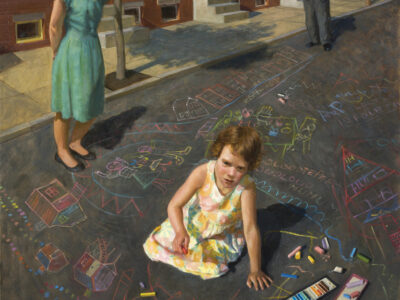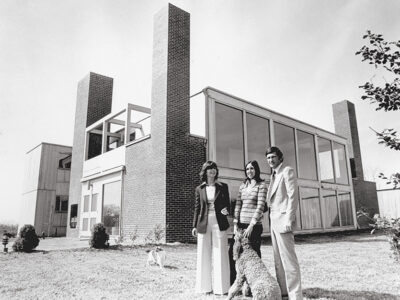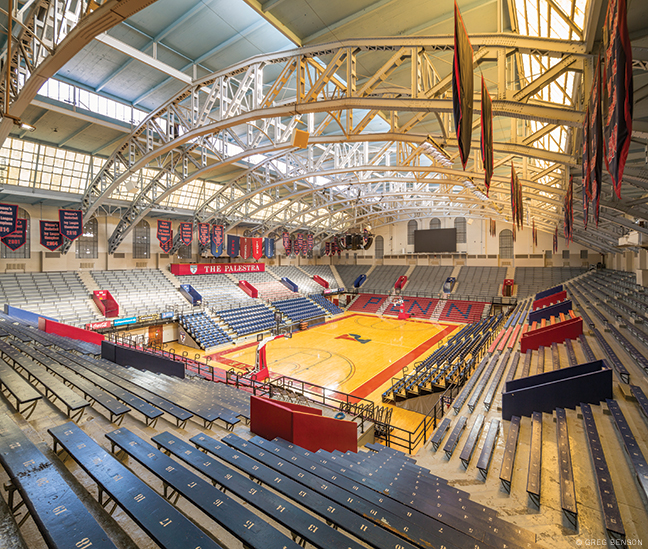
Celebrating the Palestra—the beloved “cathedral of college basketball”—at 90 years young.
BY DAVE ZEITLIN
Photography by Greg Benson
Archival photographs courtesy of Penn Athletics and University Archives
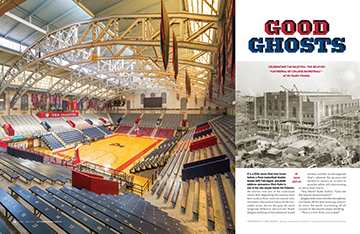
It’s a little more than two hours before a Penn basketball double header with Yale begins, and public address announcer Rich Kahn is one of the only people inside the Palestra. He nestles into one of the cushioned chairs that, beginning this season, have been used as floor seats for season-ticket holders—the newest luxury of the venerable arena. Across the gym, he spots longtime Palestra electrician Mark Quigley working on the enhanced sound system, another recent upgrade that’s allowed the 90-year-old facility to remain as current as possible while still maintaining its old-school charm.
“Hey, Mark!” Kahn hollers. “Give ’em the typical announcement!”
Quigley nods, leans into the microphone, and shows off his best booming crescendo voice, the words ricocheting off all corners of the mostly-empty building.
“This is a test. Rich, you’re late!”
Kahn lets out a hearty laugh. “That’s his thing,” the PA announcer says. “It doesn’t matter what time I get here. It’s a little joke.” The funny part is that Kahn is never late. In fact, he’s typically quite early, eager to get to work at a place he calls a “second home.” He became the voice of the Palestra 12 years ago, replacing John McAdams, whose customary greeting for every game from 1986 until his death in 2005 became a hallmark of the building: Ladies and gentleman, welcome to the University of Pennsylvania Palestra, college basketball’s most historic gym. This wasn’t hyperbole; if anything, it was an understated way to describe a venue that’s hosted more college basketball games, more NCAA Tournament games, and more visiting teams than any other arena in the country.
“I’ve worked in a lot of places, and there’s just something special about this place,” says Kahn, who originally hails from Long Island and previously served as the New York Jets’ PA announcer. “I think it’s the fact it’s not a sanitary, new behemoth of a building. It just has charm. You come in here, you just feel like you’re welcome. It’s just a comfy, cozy kind of place—with such amazing history.”
Perhaps there’s a reason Quigley likes to announce that Kahn is late. The electrician, after all, has already been inside the Palestra, where his office is located, since about 8 a.m. on this early January day as the Quakers prepare to face Yale—almost exactly 90 years after Penn played Yale in the first-ever game at the Palestra on January 1, 1927. Penn won that contest, 25-15, in front of 10,000 people (the capacity of the gym has since been reduced to a little under 9,000), then the largest crowd to ever attend a basketball game on the East Coast.
Less than 20 years later, Quigley’s grandfather, Charles, began working at Penn, eventually assuming the role of supervisor of the athletic grounds and an early Palestra caretaker. For Mark Quigley, that makes his job even more meaningful—a way to honor the legacy of his grandfather, who’s now 98 years old, in a gym they both care about.
“I get choked up,” Quigley says, perched above the court, behind one of the baskets. “It’s a place. But it’s the people that make the place.”
The Quigleys aren’t the only family that has helped pass the Palestra mystique down from generation to generation. Tony Crosson, who preceded Quigley as the gym’s electrician, worked in the Palestra for nearly 50 years, some of them while his dad served as a facilities director for the University. Scorekeeper Bruce McKee took over those duties from his late father, Bob McKee C’53, whose wife Dottie used to manually type in the list of sponsors to be displayed on the old scoreboard. The job of clock operator has been in the McCann family for many years. And Peggy Kowalski C’78 has been working around the Palestra for most of her life, following in the footsteps of her father, Bob Donohue, the arena’s ticket manager from 1970 to 1985, and her grandfather, who sold tickets in the 1940s and ’50s.
There’s no perfect way to convey the essence of the Palestra, a building that many will tell you defies description and whose stories of legendary players and memorable Philadelphia Big 5 games have been told time and again. But to peek into the daily lives of some of these behind-the-scenes workers who make the building tick—as well as fans, journalists, coaches, and former players who never want to leave—is one way to capture the spirit of the “Cathedral of College of Basketball” on its 90th birthday.
Dottie McKee is not quite as old at the Palestra, but she’s close. Now 85, she retired from her job when the new scoreboard and video board were installed in 2011, but she still comes to most games, sitting quietly by herself, a few rows up from the floor, near the home locker room. She can tell you exactly where she sat the first time she visited the Palestra in 1947 and has vivid memories of the 25 years she spent typing ads onto the scoreboard, a job she fell into when the person who normally did it failed to show up one day.
“I had to hand type everything,” she says. “There was no memory at all. Every single thing I put across the board had to be individually typed in and sometimes it didn’t work right and I would call Mark to come fix it.” That would be Mark Quigley, who just then bounds into the media room, where he spots McKee and exclaims, “She’s an icon!” McKee responds with a laugh. “I’m an icon because I’ve been here so long.” And then the two reminisce about the days when she had Quigley on speed dial to fix the old General Indicator Corporation machine she used, and he’d walk up to the “crow’s nest” just below the north Palestra rafters (now used as a secondary press box for overflow media) to make things right—the kind of unique tics that newer arenas don’t have to deal with. But they both loved it.
“It’s a good job,” says McKee, whose husband, Bob, was the Palestra scorekeeper for 47 years before he passed away in 2005. The couple had been together since the first grade, spending many nights at the notoriously overheated gym, which for them felt as romantic as any restaurant or theater.
“Yup,” Quigley responds quietly, and for a second it looks like he’s going to get sentimental again. But then he races back through the door of the media room to make sure the shot clock that’s been causing him problems is good to go before the doubleheader begins.
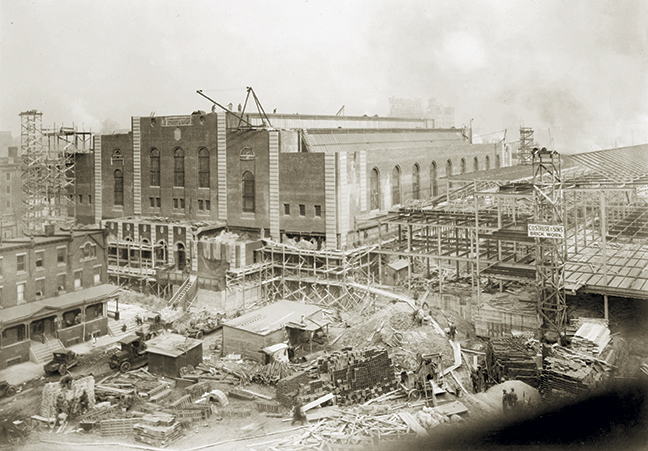
It’s early in the second quarter of the women’s game, and Dan Harrell CGS’00 is where he likes to be: deep inside the tunnels of the Palestra. Harrell admits his story has gotten “stale” because he’s been interviewed many times since he famously graduated from Penn while holding a mop at commencement—his way of thanking the University for the 10 years of night classes he took while working as the Palestra custodian [“Gazetteer,” Sep|Oct 2012]. But few people are better equipped to explain the aura of the gym than Harrell, who worked there from 1989 until his retirement in 2012, and who knows every inch of the old building.
“See this training table?” he says, walking past the referees’ locker room and into the tunnel around the perimeter of the gym. “This has to be from 1927.”
There are other pieces of history tucked away back here, in the dusty, dark recesses he calls “the heart and soul of the old building.” A couple of old lockers, perhaps from the 1950s. The door that he used to sneak into Big 5 doubleheaders as a kid, starting in 1957. An original wall from 1927—the year the Palestra was built, after it had been determined that the team’s first gym at nearby Weightman Hall was wholly inadequate and way too small. “We certainly broke all the fire laws of the city,” wrote Ralph Morgan C1906, in a framed article that hangs in the Palestra media room. A Penn basketball student manager in 1905, he founded the Intercollegiate Rules Committee and is in the Naismith Memorial Basketball Hall of Fame for his early contributions to developing the sport’s rules. Morgan went on to describe the process of designing what would be “the finest indoor auditorium in the land.” It was Greek professor William N. Bates, incidentally, who came up with the name Palestra after the ancient Greek term for a rectangular enclosure attached to a gymnasium—a name that Morgan, later a University trustee, deemed “authentic, novel, dignified and descriptive.”
Harrell passes by that framed article and other old photos often, marveling at how fans from 1927 wore suits and hats to games. In truth, though, he doesn’t need to be offered many visual reminders of the Palestra’s history. He can hear it and feel it as he walks around the gym: the sound of bouncing basketballs when the building is empty. The mist at the end of the concourse. The drastic change of temperature as he passes by a team’s bench. There are ghosts, he insists, that make the Palestra the special, spirited building that it is.
“Let me put it this way—you’re never in here by yourself,” says Harrell, echoing a famous comment once made by longtime Saint Joseph’s University head coach Phil Martelli: “The Palestra is unique because it’s the only empty building in America that you can go into and there’s sound.”
In his old job, Harrell would hear the noises at 5 a.m., brushing past the ghosts—“good ghosts,” he assures—as he mopped the floor and prepped the gym for a day of use by any of the regular occupants: Penn’s men’s and women’s basketball teams, or the volleyball, gymnastics, or wrestling squads.
He still returns to the Palestra often, sometimes to help out equipment managers John Borraccini and Jack Wilson on game days. How much work he does, though, is up for debate. “Did he say he fires me every day?” Harrell says of Borraccini. “He says the activity goes down the tubes every time I walk through the door.” But the three of them do make quite the team. “Honestly, I think they should do a reality show with Mr. Jack, Dan Harrell, and Johnny B and just follow them around,” says men’s basketball assistant coach Nat Graham C’97. “It would be unbelievable. There are so many characters around here.”
Borraccini has been employed by the University for almost 30 years and has one of the Palestra’s most unique vantage points, working in an office directly off the court, next to the visitor’s locker room and one of the four ramps that lead up to the concourse. There will be days when he’s sitting in his office that it literally begins to shake. Then he’ll open his door, take a few steps, and sit among the fans to watch great games unfold, like the time Lionel Simmons and La Salle beat Florida State in triple overtime in 1989. “You take it for granted,” he admits. “During the day, no one else is here. But when people start making their way in, you kind of realize, ‘Wow, I’m at the Palestra.’”
Like Harrell, Borraccini can’t escape the gym’s history. He walks on the original basketball floor every day, which is underfoot where he cleans uniforms and practice shirts. And tucked away in a box near those industrial-sized washers and dryers are stacks of old alphabet letters, which he, Quigley, and others once used to manually spell out team names on the old scoreboard, sometimes four different times in one day—like when the Atlantic 10 Tournament was held in the Palestra in the 1990s (having to squeeze in between fans to get to it). It was only in the past decade that Penn installed a new floor and a digital scoreboard. Those important renovations made their jobs easier, but Harrell never craved any upgrades.
“What was here in 1957 is good enough for me now,” he says wistfully. “You know when you get old, you get a hip replacement or knee replacements? The Palestra will never need that. She’s solid. She just needs to be spruced up every once in awhile. She’ll last forever, as long as you take care of her.”
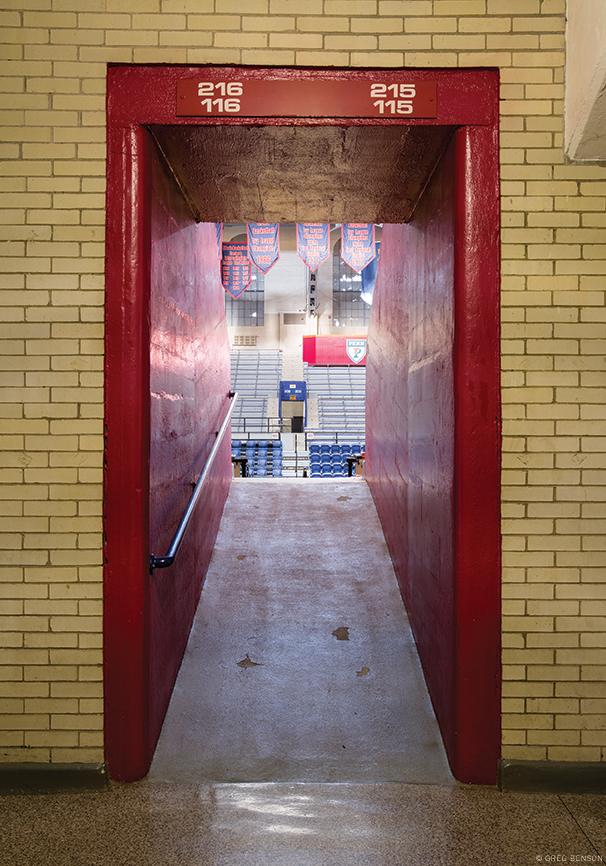
It’s between games of the doubleheader. The Penn women have just beaten Yale 66-55 for their first win of the season at the Palestra. The fact that the Quakers had lost their first three home games seemed surprising, given that everyone had returned from last year’s Ivy League championship team. But head women’s coach Mike McLaughlin admits that the home-court advantage and mystique of the Palestra may not be quite as strong for his squad, since many of his players aren’t from the area and don’t know the history that well.
McLaughlin, however, does his best to change that, taking the team on tours of the building, where photos and plaques hang on the concourse—including a few recognitions of the women’s team (which will be bolstered soon thanks to the program’s two recent Ivy titles). He also draws on his personal experience growing up in the Philly area, pointing out for players exactly where he sat as a kid going to Big 5 games with his father, who now sits in those same stands to watch his son coach.
“I feel the same way here as the first day I walked in,” says McLaughlin, who’s been at Penn since 2009. “When you hear guys say it’s a bucket-list place to play, I never want to take that for granted. This is pretty special.”
Among the coaches and announcers who have put the Palestra on their bucket list is legendary Michigan State coach Tom Izzo, who on January 7 coached his first-ever game in the historic arena. Michigan State’s game vs. Penn State got set up because Penn State has several Philadelphia natives on its roster, including head coach Pat Chambers, whose brother Paul C’92 played for the Quakers. Izzo agreed to the game because he wanted a chance to walk the same sidelines that so many great coaches have walked—though, after a 72-63 loss, he apologized to the “magnificent facility” itself for his team’s lack of effort. (In a column the next day, Philadelphia Inquirer college basketball writer Mike Jensen wrote, “Reached later for comment, the building accepted the apology.”)
Michigan State’s poor performance aside, the game was a very successful event, with fans braving snow to pack the gym to the rafters. And in their postgame press conferences, Izzo and Chambers each expressed the joy they felt coaching inside the famously no-frills arena.
“To walk in the locker room and not see any jacks for WiFi and phones and Twitter, God it was great, you know?” Izzo said. “I told our guys we’d probably have to hang our coats on hooks. We didn’t even have hooks in there! It was awesome. It was just awesome. I threw my damn coat on the floor and said, ‘This is where it belongs. This is some humility.’ And we need some humility right now.”
Added Chambers: “The lighting. The smell. It’s a gym. It’s a gym. I was drenched. I had to get changed. I was drenched underneath my coat. And you just love it. You love every second, every sweat, every drop.”
Although the home locker room has been significantly spruced up with, among other upgrades, outlets at every locker (sorry, Coach Izzo), the locker rooms for visiting teams indeed lack much of anything beyond a few chairs and a few lockers. And the brutal heat and funky smell that Chambers described is something that Penn men’s basketball coach Steve Donahue knows quite well.
“It gets really hot and starts to smell like an old gym,” says Donahue, an assistant at Penn from 1990 to 2000, who then went on to head-coaching stops at Cornell and Boston College before returning to the University in 2015. “You smell the popcorn coming down. It’s great.”
Like McLaughlin, Donahue’s feelings about the Palestra stem from his memories of coming as a kid. His first game was in 1974 when he took a bus with his youth basketball team, watched Ron Haigler C’79 GEd’99 sink a game-winner for the Quakers, and was wowed by the “intimacy” of a gym where there are only 28 rows from courtside to the back wall and no bad seats anywhere. Later, as a high-school player for Cardinal O’Hara, he and his teammates wore practice jerseys with Palestra on them because the Philadelphia Catholic League semifinals and finals are one of the biggest events held at Penn’s arena every year. He got there during his junior and senior seasons at O’Hara, and then won a Catholic League championship in the gym as an assistant coach with Monsignor Bonner High School in 1988. So by the time he was working as an assistant coach under Fran Dunphy at Penn, he was well versed in the building’s lack of luxuries—and was pleased to learn that didn’t change for college games.
“Dunphy, for years, fought having cushioned seats for coaches and players,” Donahue says. “We sat on a bench the whole time he was here. I thought that was neat—it gives it the feel of a high-school gym. I coached in the [Atlantic Coast Conference, where the facilities are top-of-the-line] and know what that’s like, and this is way more fun.
“I can look up at the stands and see the face of the person in the last row. That’s the last row of the building! And that person has an intimate look at what’s going on. I’ve coached at Phog Allen [Kansas], I’ve coached at Cameron [Duke], I’ve been to Hinkle [Butler]—and I just don’t think there’s any Palestra. This one is as tight as it can be on top of you.”
Donahue’s two top assistants, Graham and former Quaker star Ira Bowman W’96, agree.
“It takes basketball back to its essence,” Bowman says. “I’m more of an old-school guy deep down. Nowadays we can get caught up making everything convenient or making everything very luxurious. In basketball you don’t need all of that. When you first learn to play, you get thrown a rubber ball out on asphalt. It takes you back to the bare necessities and what you really need to enjoy the game.”
“You just feel the crowd so much more here,” adds Graham, a member of Penn’s Ivy-title winning teams in 1994 and 1995. “You go to some other places and you don’t really hear anything … Before a game once, I was sitting on the bench and a kid from Yale came up to me and said, ‘Do your players get how awesome it is that they get to play and practice here all the time?’”
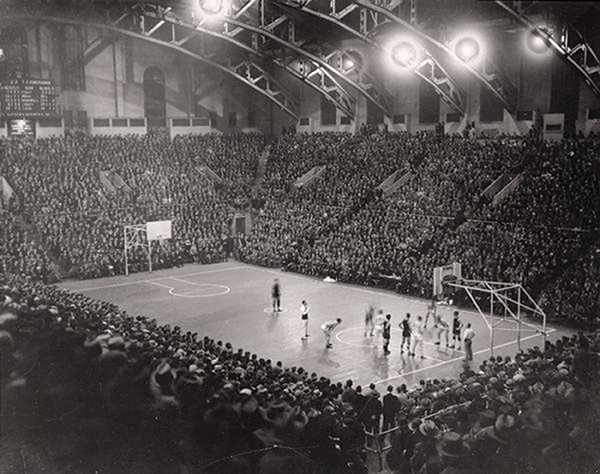
It’s a few moments after the doubleheader has ended, and fans are streaming out of the Palestra. One of the last people to leave remains beside his chairback seat following Penn’s 68-60 loss to Yale, slowly buttoning his jacket and shaking hands with several other fans. In another venue, perhaps, somebody like Ed Rendell C’65 Hon’00 would be in a luxury box. But here, in the cozy confines of the Palestra where those sorts of things don’t exist, the former Philadelphia mayor and Pennsylvania governor is comfortable sitting near where he sat during his undergraduate days—close enough to the floor to yell at the referees, as he’s prone to do. Of course, he could probably do that effectively from any seat.
“You can go up to the dead corner and still see the game better than two-thirds of the seats in the Dean Dome” at the University of North Carolina, Rendell says. “It’s just an incredible place to watch a game. The acoustics are unbelievable.”
Rendell fell in love with the Palestra as a student, missing his train back to New York before winter break because a December 22, 1962 game vs. St. Joe’s went to triple overtime. That was his first game, and he’s returned countless times since—his favorite moment coming in 1970-71, when the Quakers overcame a seven-point deficit to Princeton in the final two minutes and kept their unbeaten season alive thanks to Corky Calhoun W’72 burying a clutch game-tying jumper in the final seconds of regulation [“Almost Perfect,” Mar|Apr 2011].
For many other spectators, Penn-Princeton games throughout the years represent the perfect storm of noise and magic. That includes former player and Penn athletic director Steve Bilsky W’71, who can’t remember the gym ever being as loud as when Tim Begley W’05 sparked a remarkable 18-point comeback against Princeton in 2005. It also includes George Loomis WEv’79, whose favorite Palestra games are, simply, “any time we beat Princeton.”
While Rendell is probably the most famous Penn basketball fan, Loomis is certainly the most dedicated. He had attended an incredible 376 straight games—including two in Hawaii in 2005—before ending his streak on December 30, 2014 when he missed a Penn-La Salle game because he had to fly to Florida for his granddaughter’s New Year’s Eve wedding.
His home-game streak is still alive and well, though; he hasn’t missed a men’s basketball game at the Palestra since he started going while working next door in Penn’s physics department in the 1960s.
“It’s quite a place, that’s for sure,” Loomis says, just as two more longtime Palestra regulars—Wayne Thompson Jr. W’57 and Clarke Glennon W’55—spot him in the concourse at half-time of the women’s game against Yale and join in reminiscing about their favorite Penn players, from the great Ernie Beck W’53 (“The best I ever saw,” Glennon marvels) to NCAA Final Four hero Tony Price W’79 (“He’s right up there,” Thompson says) to diminutive point guard Zack Rosen W’12 (“Pound for pound the best player that was ever here,” Loomis says).
But to get an even truer sense of 90 years of Palestra history, listen to Thompson talk about his father, Wayne C’27, a construction worker who “actually worked on this building” when it was being built, he says. “He said the center beam swayed, and they thought it was gonna go timber.”
The Palestra, of course, ended up being quite sturdy—a brick-and-steel creation that everyone says was built to last. But while so much of the architecture makes the Palestra what it is today—the high ceiling, the cathedral-like arches hanging overhead, the close seating without any obstructed views—Loomis and friends have seen several renovations designed to boost the fan experience over the years. The biggest came in 2000 when Bilsky, who had recently visited Cooperstown, thought “it would be neat to make the concourses a museum to Philadelphia basketball.” Along with the concourse, locker room, sound system, and floor, other upgrades have included new seating, new doors, and LED lighting, which allows for a light-show during Penn’s pregame introductions. Massive renovations to neighboring Hutchinson Gymnasium also created extra rooms for ticket-holders to enter and enjoy halftime refreshments. “But I don’t think in doing so we changed it from the feel that existed in 1927,” says Bilsky, who retired as Penn’s AD in 2014 [“Passing the Baton,” Sep|Oct 2014].
There could be more renovations on the horizon. Palestra electrician Mark Quigley believes a general infrastructure overhaul is needed; Rendell hopes to see the outer part of the building “modernized”; and Bilsky thinks the museum—and bathrooms—need updating. Peggy Kowalski, who used to run the Palestra box office and now oversees events for athletics donors, said there have been discussions about finally adding an air-conditioning system so the “sweatbox” of a building can be used more in the summertime.
While Bilsky and others have lamented that the Palestra no longer hosts all Big 5 games, it still has its share of unique events. Last year, in his current job as the Big 5’s executive director, Bilsky organized a Big 5 doubleheader—a callback to the days when they were the norm and fans threw streamers onto the court and unfurled rollouts with clever taunts of the opposition.
The Michigan State-Penn State game in January was “the most talked about college game in Philadelphia this year” and “a great national showcase for the Palestra,” Bilsky says. Other recent memorable moments included when ESPN College GameDay set up its show on the Palestra floor before a Temple-La Salle game in 2014 and when LeBron James and other pro stars visited the gym during the 2011 NBA lockout for an exhibition game dubbed the “Battle of I-95.”
LeBron had previously passed through the Palestra’s hallowed halls as a high-schooler in 2002, following in the footsteps of Wilt Chamberlain, Oscar Robertson, Jerry West, and Kobe Bryant, among other legends. Kowalski was in the building to see both LeBron and Kobe, and believes the general admission crowd on hand to watch Bryant and Lower Merion take on Chester in the 1996 state semifinals may have been the largest ever.
But, as with many others, her favorite story came during a Penn-Princeton game: in 1998, a Princeton fan shot off a firecracker that flew down to the section below. Doing her due diligence on what could have been a scary incident, Kowalski went to fans in the general vicinity to get their information—only to be rebuffed. “Everyone said, ‘Let’s do it at halftime,’” Kowalski recalls. “Every one of them. People had damaged coats. But they did not want to stop watching the game.”
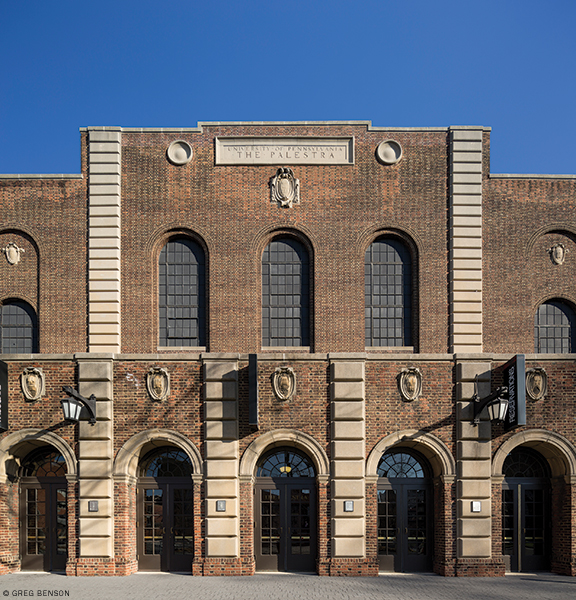
It’s the morning after the women’s win and the men’s loss to Yale, and a custodian is sweeping the Palestra floor. Occasionally, he stops what he’s doing to watch a group of men, some as old as 70, many in knee braces, playing a heated but fundamentally sound full-court game. “A lot of heady basketball,” former Quaker forward Jed Ryan W’99 puts it with a smile, referring to the relatively cerebral style of play. “Probably more than we need to have. Some possessions become frustratingly long with a series of wonderfully executed picks.”
It’s been like this for nearly 30 years, the Saturday morning pickup games beginning when Donahue first became an assistant coach. Back then, he’d change the outgoing message on the answering machine in the coach’s office to let people know if the game was on. Now, there’s a huge email chain that includes many former Penn basketball players. On this Saturday, two of them—Ryan and Steve Danley C’07—just got done winning every game, showing off some of the (now slightly fading) skills that helped them forge successful collegiate careers. More important, the fact that they were even allowed in the gym between two Penn doubleheaders—following Friday’s Yale games, the Quakers would face Brown that Saturday night—is a testament to how unlike most other facilities the Palestra is.
“This building is about history, but it’s also about community,” says Danley, who won Ivy League titles in his final three seasons. “Everyone thinks of the Palestra when there are Big 5 games and it’s full. But the biggest privilege as a player is being here when it’s empty.”
Scott Kegler C’95, a sharpshooter who won Ivy titles in his final three seasons, can attest to that feeling of inclusion and community. He had his 30th and his 40th birthday parties at the Palestra. (There are other examples of Penn grads holding pre-bachelor parties in the gym, and the author of this article had his groomsmen sweat through a July photo session inside the building before getting married at the Penn Museum.) And he’s happily taken on the long-running role of “commissioner” of the Saturday morning games.
“We kind of all pinch ourselves when we get here in the morning, and we’re the only ones here,” Kegler says. “The emotions and everything are exactly the same as they used to be. What’s different is our ability to do what we used to do. But it feels the same way. I think about it all week. If we win or lose on Saturday, we all think about it.”
The games certainly do get intense. Vince Curran EAS’92 W’92, a former player and current radio announcer, ran the league before Kegler and noted there were “more than a couple of dust-ups between guys who were best friends.” But, in a way, that just made it feel like it did back during their college days. “You get one more chance to play in the greatest place in the world,” Curran says. “It’s a magical place. It’s Disney World for hoopheads.”
Once, during a particularly raucous Palestra game in college, Curran remembers a former Princeton player looking him in the eye and declaring, “If I had known it would be like this, I probably would have come here.” That’s because of how loud it gets. “Deafening isn’t the right word—you can actually feel the sound,” Curran explains. Danley concurs: “There’s loud, and there’s so loud that you literally stop thinking anything.” That’s why Curran has relished the chance to remain in the gym, trying to talk over the noise as the radio color-man.
Stan Pawlak W’66, another current Penn radio announcer, feels the same way. “Coming back keeps me young,” says Pawlak, whose final game as a player was an Ivy-clinching win over Princeton at the Palestra. “It’s the same building. It’s terrific they honor me enough to bring me down here, and I’ll do it as long as they’ll have me.”
Former women’s player Mikaelyn Austin C’04 made the documentary film The Palestra: Cathedral of Basketball, which was picked up by ESPN, shortly after her playing days were done [“Gazetteer,” Jul|Aug 2007]. And then there are the media members who have become staples of the Palestra while making lasting contributions to its history. Former Philadelphia Daily News and New York Daily News writer Dick “Hoops” Weiss, uttered the famous line: “I don’t know how to explain it. It’s a basketball cathedral.”
Weiss said he came up with the nickname because the building looks like a church when you gaze upward. “And it kind of was my church,” says Weiss, who went to every game in the gym from 1965 to 1975 and many more over the past four decades. “They better make it a national historical monument, because I don’t want it to ever come down,” Weiss says. “It has some magic in it.”
Longtime Associated Press correspondent Jack Scheuer—who’s six years younger than the Palestra and played in the gym in 1949 and 1950 for Frankford High—might be the only person who’s been to more Palestra games than Weiss. One of them was the “Bomb Scare Game” in 1959 when everyone was evacuated except, as the story goes, TV announcer Les Kes Keiter. Scheuer just has one addendum: “I stayed too,” he says, adding: “I never want to leave the building, ever.” That makes sense for “the all-time leading scorer in Palestra history”—a title Scheuer, who has a mean set-shot, has earned by playing in the Wednesday afternoon media pickup games there every week for the last 44 years. “I still get a thrill walking down that ramp, I really do,” Scheuer says. “It’s a part of my life.”
Throughout the 2016-17 season, Penn has been paying homage to the gym’s illustrious history. Players’ warm-up shirts commemorate the 90-year anniversary, and an official birthday party was held during Penn’s game against Princeton on February 7. Student tickets cost 55 cents (the price to see the original Penn-Yale game in 1927) and popcorn went for 90 cents, among other promotions. And this season will culminate with the Palestra hosting the first-ever Ivy League Basketball Tournament.
As for the future, “I don’t see any reason why it can’t live at least another 90,” says Donahue, who sometimes likes to bring his lunch or dinner to eat on the bleachers of the empty gym. “I was at the last game at Connie Mack. Obviously that’s gone. I went to the Spectrum. That’s gone. The Vet’s gone. The Convention Center where the Sixers played, that’s gone. This is it. This is the crown jewel and it’s still here, and I think it’s awesome that it is.”
Dave Zeitlin C’03 writes frequently for the Gazette.



